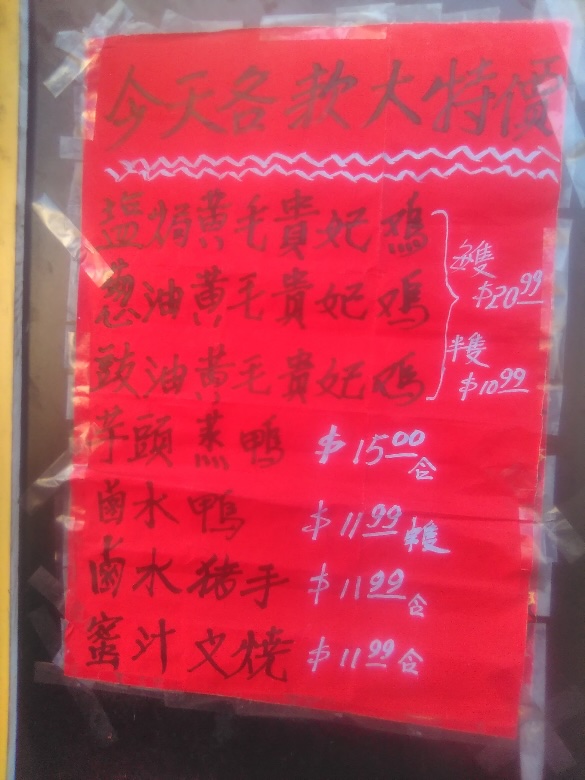Archive for Language and food
Analogy of the week
From Dan Fagin, "We Can Now Track Individual Monarch Butterflies. It’s a Revelation.", NYT :
For the first time, scientists are tracking the migration of monarch butterflies across much of North America […]
The breakthrough is the result of a tiny solar-powered radio tag that weighs just 60 milligrams and sells for $200. […]
Most monarchs weigh 500 to 600 milligrams, so each tag-bearing migrator making the transcontinental journey is, by weight, equivalent to a half-raisin carrying three uncooked grains of rice.
Read the rest of this entry »
Semiliterate restaurant Chinese
Charles Belov saw this sign on Clement Street (aka New Chinatown) in San Francisco:
Read the rest of this entry »
Disposal bin
Photograph taken at the Ningbo airport: those items are not allowed to be taken into the city of Ningbo.
zìyuàn fàngqì wùpǐn tóuqì xiāng
自愿放弃物品投弃箱
"disposal bin for items voluntarily discarded"
Read the rest of this entry »
Study Reveals America's Most Searched Slang Words 2025 / OHIO; mayonnaise
[This is a guest post by Randoh Sallihall]
Analysis of Google search data for 2025 reveals the most searched for slang words in America.
Read the rest of this entry »
Spanakopita: a spinach footnote
We have had so many posts dedicated to Popeye's favorite vegetable (see "Selected readings" below), but we haven't yet done justice to one of my favorite spinach dishes: spanakopita.
Spanakopita (/ˌspænəˈkɒpɪtə, ˌspɑː-, –ˈkoʊ-/; Greek: σπανακόπιτα, from σπανάκι spanáki 'spinach', and πίτα píta 'pie') is a Greek savory spinach pie. It often also contains cheese, typically feta, and may then be called spanakotiropita (Greek: σπανακοτυρόπιτα "spinach-cheese pie"), especially in northern Greece.[citation needed] In southern Greece, the term spanakopita is also common for the versions with cheese.
Read the rest of this entry »
Udon, wontons, & pansit
(Since we have previously had lively discussions on subjects related to today's topic, I will publish this essay as is, but with the admonition that it is for advanced Siniticists, though naturally all Language Log readers are welcome to partake.)
[This is a guest post by Kirinputra]
I was (routinely) digging into the etymology of Taioanese U-LÓNG, which, like UDON, comes from Japanese うどん, and it turns out that うどん is cognate to WONTON, Cantonese 雲吞 (of c.), & Mandarin 馄饨.
The 廣韻 has 餛飩; so does Cikoski, with the gloss K[IND OF] DUMPLING. So the word is pretty ancient. 集韻 has it written 䐊肫, apparently. Using that as a search term, I found an article on your blog, but the commenters were generally unaware that 餛飩 had this alternate form in the medieval book language. (Of c., the person that wrote 䐊肫湯 may not have known either.)
Read the rest of this entry »
Two new kinds of tea
Since I wrote The True History of Tea (2009; now available in a number of foreign languages and coming out in pb on 1/27/26), I've been a tea aficianado and connoisseur, so I was stunned when five days ago I learned of the existence of two types that are completely new to me.
The first is called Adeni tea, and I was privileged to taste it at Haraz Coffee House that recently opened next to Penn. It is run by Yemenis, who really know their coffee and serve mouth-watering pastries, many of which I had never encountered before.
I already had a good impression of Yemeni food purveyors when I stopped at a Country Market by the side of Old Route 30 in Svensen WA run by a mother and her son, though I didn't have any hot, freshly brewed tea that time.
Read the rest of this entry »
Double Cao
On first blush, I thought perhaps the person pictured had a double chin, and by cropping the photo this way they were trying to hide it. On second blush, it was clear that they had misinterpreted the name of the famous 2nd c. statesman, general, and poet, Cao Cao 曹操 (ca. 155-220 AD).
Read the rest of this entry »
Proto-emoji
At the Swarthmore Farmers Market this past Saturday morning, I came upon a new stall selling onigiri, which are Japanese rice balls, a popular and versatile snack or meal component. They consist of steamed rice formed into various shapes, often triangles, and typically filled with savory ingredients like pickled plums (umeboshi), salmon, or tuna with mayonnaise. They are often enclosed in nori (seaweed).
These onigiri were wrapped in cellophane and had a label stuck on the side. As soon as I saw the design on the label, which looked like a human face, I found that I could "read" it:

Read the rest of this entry »
Spinach smorgasbord
I want to thank Jonathan Silk (comment here) for pushing Popeye to further heights and deeper depths in our understanding of his favorite vegetable. We're not "finiched" with spinach yet.
Now it's getting very interesting and confusing (Armenian is creeping in):
palak
English
Etymology
From Hindi पालक (pālak), from Sanskrit पालक्या (pālakyā).
Noun
palak (uncountable)
-
- (India, cooking) Spinach or similar greens (including Amaranthus species and Chenopodium album).
Read the rest of this entry »
Spinach: Mongolian rhapsody
[This is a guest post from Christopher Atwood]
Building on observations of Andras Rona-Tas (Tibeto-Mongolica, pp. 213-14), one can observe a basic division in Mongolian words for cultivated plants. They divide into two types: 1) words for grains and grain cultivation; and 2) words for fruits and vegetables.
Words in the first category (tariya "grain" buudai "wheat," arbai "barley," shish "sorghum," am "millet," budaa "grain," anjisu "plow" mill "teerem" etc) are consistent throughout the Mongolic family, and have great time depth — most of them are not obviously loan words from any other language (some have Turkic cognates, but at a considerable time depth).
Read the rest of this entry »



